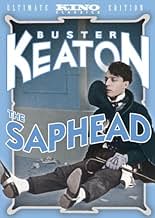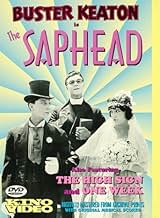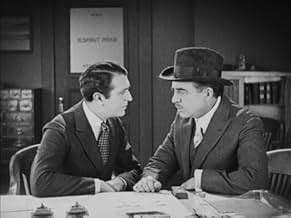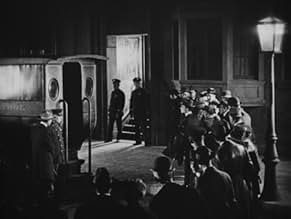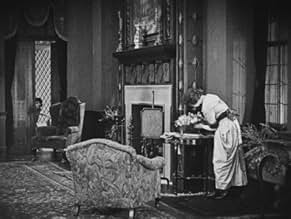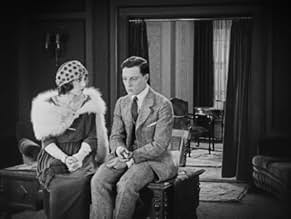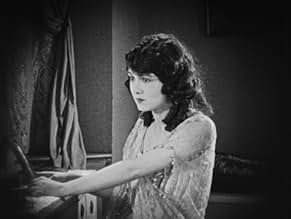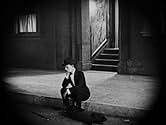AVALIAÇÃO DA IMDb
6,1/10
1,9 mil
SUA AVALIAÇÃO
Adicionar um enredo no seu idiomaThe simple-minded son of a rich financier must find his own way in the world.The simple-minded son of a rich financier must find his own way in the world.The simple-minded son of a rich financier must find his own way in the world.
- Direção
- Roteiristas
- Artistas
- Prêmios
- 1 indicação no total
Katherine Albert
- Hattie
- (não creditado)
George Berrell
- Jim Hardy from Arizona
- (não creditado)
Henry Clauss
- Valet
- (não creditado)
Alfred Hollingsworth
- Hathaway
- (não creditado)
Helen Holte
- Henrietta Reynolds
- (não creditado)
Jeffrey Williams
- Hutchins
- (não creditado)
Avaliações em destaque
"Saphead" is an awful romantic melodrama. Basically Keaton is just doing straight acting (the movie's based on a stage play). There is little comedy here.
But the 2 shorts included on the DVD -- "The High Sign" and "One Week" --are outstanding. They rate 8 and 9 scores, respectively. "One Week" anticipates many of Keaton's later gags and stunts, showing the kind of imagination and skill that made his films the funniest of the silent era (sorry, Charlie).
But the 2 shorts included on the DVD -- "The High Sign" and "One Week" --are outstanding. They rate 8 and 9 scores, respectively. "One Week" anticipates many of Keaton's later gags and stunts, showing the kind of imagination and skill that made his films the funniest of the silent era (sorry, Charlie).
Before I watched "The Saphead" I was under the impression that it was a Buster Keaton comedy, rather than a straight drama that starred Buster Keaton. For the first twenty minutes or so I was rather confused by the lack of jokes but then after a quick Google search I figured out what was happening.
After I realised what the nature of the film was, I found it pretty enjoyable. It's nothing special but it also isn't totally forgettable. The story may not be totally original but it did have some interesting beats in it that I wasn't expecting.
Keaton does a really good job in this role, and he even gets some moments to show off his comedic talents to the audience (the most notable being the stock market scene, which gets some decent laughs).
So yeah, overall it's nothing special but it's a decent watch and the feature film debut of a comedy legend.
After I realised what the nature of the film was, I found it pretty enjoyable. It's nothing special but it also isn't totally forgettable. The story may not be totally original but it did have some interesting beats in it that I wasn't expecting.
Keaton does a really good job in this role, and he even gets some moments to show off his comedic talents to the audience (the most notable being the stock market scene, which gets some decent laughs).
So yeah, overall it's nothing special but it's a decent watch and the feature film debut of a comedy legend.
The Saphead" does not showcase Keaton the filmmaker, but rather Keaton the actor. The script is from a play, the directors are individuals Keaton never worked with before or hence, and the studio was Metro, predecessor of MGM. Keaton plays Bertie the Lamb, mild-mannered and spoiled son of Nick Van Alstyne, "the Wolf of Wall Street". In spite of the fact that Keaton had no creative input to the film and isn't actually its centerpiece, there is much to like about this film and much that is so Keatonesque. Keaton plays an old-fashioned romantic and someone that is thrust into the role of the fall guy by the actual bad guy - a theme he repeats in his own features. He also has down pat the part of being the well-dressed dapper man of the 1920's, which he repeats with more comic effect in "The Battling Butler", where he did have creative control.
He's rich, he's a bit lazy, he gets the girl in the first half-hour, he even smiles a bit. It's not the Buster Keaton you expect. But he's still Keaton, and even if his first feature film creaks a good deal, he keeps you entertained.
"The Saphead" presents the story of Bertie Van Alstyne (Keaton), son of Wall Street tycoon Nicholas Van Alstyne (William H. Crane). Bertie lives a life of Manhattan luxury but secretly pines for the beautiful Agnes (Beulah Booker), who secretly pines for Bertie in turn. Happiness appears at hand until a strange turn of events shatters their union.
A 1920 production of a hit stage play, "The Saphead" was designed to fit audience conventions of the day, not showcase Keaton's still-emerging comic persona. Sentiment and improbable coincidences run rampant here. Given that, it's impressive how well the Keaton we would come to know is presented. He is given many chances to present his clownish athleticism, as well as that expressionless-yet-not-emotionless manner that has beguiled film lovers for decades.
Was Herbert Blaché, the credited director, preternaturally wise to Keaton's style? Or did Keaton just know how to get his way even before he enjoyed full control of his features?
The problem with "The Saphead" is not Keaton, but its construction. In the first ten minutes, we are introduced to everyone in the film except Bertie, and given background about an adulterous affair that is then dropped for the Bertie story. Forty-five minutes in the two story lines come together, and in such a convoluted way as to beggar belief. Bertie is somehow pressed into taking the blame for the affair, even though it's obvious his brother-in-law is the guilty party.
Cue violins. A lot of "The Saphead" works toward this kind of sentimental dithering, even the Keaton parts, which get a bit strange. Bertie confesses his love to Agnes accidentally, when he tells his sister Rose about it. (Since Nicholas Van Alstyne adopted Agnes, doesn't that make her Bertie's sister, too?) Agnes is standing right there, though, and gives Bertie a bit of a shock before he recovers and takes her hand. This is strictly Buster for the old ladies.
The best way of watching "The Saphead" is as a couple of clever Keaton shorts with workmanlike connecting material. The first short would be Bertie's attempt to live a wastrel life, not because his heart is in it, but because he believes the modern woman "prefers sports to saints". To this end, in a great bit of physical comedy, Bertie tries to get arrested when his speakeasy is raided even though he successfully bribed a detective without knowing it. Every time he tries to enter the paddy wagon, someone pushes him back out.
The second short would be Bertie making his way on Wall Street in the last 20 minutes, overdressed in top hat, frock coat, and spats, being razzed by the other brokers. This culminates in a scene of wild physical comedy where Keaton runs around the trading floor, jumping on people and unknowingly buying up shares in his father's precious mine.
The Kino DVD I saw this on also has two shorts Keaton made at the same time, "The High Sign" and "One Week", which display Keaton as both director and star, and in much sharper form. "The Saphead" lacks the inventiveness of those shorts, but it works off-and-on as period entertainment thanks to Keaton and a good supporting cast. Booker is a typically shy Keaton-film beauty who delivers her scenes with grace. Crane has a fine comic moment sending his disgraced son off with a check for one million dollars "and not a penny more!"
It's not great cinema, but it's the start of great cinema, showing some the conventions of the time Keaton would do his part to break, and other conventions he would observe, en route to glory.
"The Saphead" presents the story of Bertie Van Alstyne (Keaton), son of Wall Street tycoon Nicholas Van Alstyne (William H. Crane). Bertie lives a life of Manhattan luxury but secretly pines for the beautiful Agnes (Beulah Booker), who secretly pines for Bertie in turn. Happiness appears at hand until a strange turn of events shatters their union.
A 1920 production of a hit stage play, "The Saphead" was designed to fit audience conventions of the day, not showcase Keaton's still-emerging comic persona. Sentiment and improbable coincidences run rampant here. Given that, it's impressive how well the Keaton we would come to know is presented. He is given many chances to present his clownish athleticism, as well as that expressionless-yet-not-emotionless manner that has beguiled film lovers for decades.
Was Herbert Blaché, the credited director, preternaturally wise to Keaton's style? Or did Keaton just know how to get his way even before he enjoyed full control of his features?
The problem with "The Saphead" is not Keaton, but its construction. In the first ten minutes, we are introduced to everyone in the film except Bertie, and given background about an adulterous affair that is then dropped for the Bertie story. Forty-five minutes in the two story lines come together, and in such a convoluted way as to beggar belief. Bertie is somehow pressed into taking the blame for the affair, even though it's obvious his brother-in-law is the guilty party.
Cue violins. A lot of "The Saphead" works toward this kind of sentimental dithering, even the Keaton parts, which get a bit strange. Bertie confesses his love to Agnes accidentally, when he tells his sister Rose about it. (Since Nicholas Van Alstyne adopted Agnes, doesn't that make her Bertie's sister, too?) Agnes is standing right there, though, and gives Bertie a bit of a shock before he recovers and takes her hand. This is strictly Buster for the old ladies.
The best way of watching "The Saphead" is as a couple of clever Keaton shorts with workmanlike connecting material. The first short would be Bertie's attempt to live a wastrel life, not because his heart is in it, but because he believes the modern woman "prefers sports to saints". To this end, in a great bit of physical comedy, Bertie tries to get arrested when his speakeasy is raided even though he successfully bribed a detective without knowing it. Every time he tries to enter the paddy wagon, someone pushes him back out.
The second short would be Bertie making his way on Wall Street in the last 20 minutes, overdressed in top hat, frock coat, and spats, being razzed by the other brokers. This culminates in a scene of wild physical comedy where Keaton runs around the trading floor, jumping on people and unknowingly buying up shares in his father's precious mine.
The Kino DVD I saw this on also has two shorts Keaton made at the same time, "The High Sign" and "One Week", which display Keaton as both director and star, and in much sharper form. "The Saphead" lacks the inventiveness of those shorts, but it works off-and-on as period entertainment thanks to Keaton and a good supporting cast. Booker is a typically shy Keaton-film beauty who delivers her scenes with grace. Crane has a fine comic moment sending his disgraced son off with a check for one million dollars "and not a penny more!"
It's not great cinema, but it's the start of great cinema, showing some the conventions of the time Keaton would do his part to break, and other conventions he would observe, en route to glory.
Something like The Saphead isn't what you would expect to be Buster Keaton's feature film debut. The whole thing seems too ordinary, too stagey and melodramatic to be so. This is due to the fact that The Saphead was not a Keaton-helmed project; he was suggested for the role of the rich young man Bertie by Douglas Fairbanks, who had previously played the role on Broadway.
Bertie is the first of the spoiled, clueless young man types that Keaton would later return to in The Navigator and Battling Butler. He seeks to impress a sweet young woman named Agnes by coming across as a bad boy, gambling well into the morning hours and having breakfast in the afternoon. His father confronts him about this behavior and has him cut off until he can find a job. Bertie seeks out to do just that, in the meantime winning the hand of his girl-- well, almost. During the ceremony, his sister's slimy husband Mark receives letters from his recently deceased mistress Henrietta, asking him to take care of their illegitimate child. His secret about to be revealed, he presses the letters on Bertie, breaking Agnes' heart and bringing the union to an abrupt end. Fortunately, things manage to pick back up after Bertie unwittingly saves the family stock business.
While there are a few Keaton-esque moments every now and then, for the most part The Saphead is just a typical stage to film adaptation of the period. Unlike the films Keaton would later star in and direct, this picture lacks spontaneity and laughs. The action on screen never comes alive until the climax, when Keaton finally gets to jump and be thrown around as he dashes through the trading floor and saves the day. The entire movie isn't a bore, however, and there are a few humorous inter-titles and gags, but it's just doesn't have a story that seems to suit the particular talents of its main star.
Bertie is the first of the spoiled, clueless young man types that Keaton would later return to in The Navigator and Battling Butler. He seeks to impress a sweet young woman named Agnes by coming across as a bad boy, gambling well into the morning hours and having breakfast in the afternoon. His father confronts him about this behavior and has him cut off until he can find a job. Bertie seeks out to do just that, in the meantime winning the hand of his girl-- well, almost. During the ceremony, his sister's slimy husband Mark receives letters from his recently deceased mistress Henrietta, asking him to take care of their illegitimate child. His secret about to be revealed, he presses the letters on Bertie, breaking Agnes' heart and bringing the union to an abrupt end. Fortunately, things manage to pick back up after Bertie unwittingly saves the family stock business.
While there are a few Keaton-esque moments every now and then, for the most part The Saphead is just a typical stage to film adaptation of the period. Unlike the films Keaton would later star in and direct, this picture lacks spontaneity and laughs. The action on screen never comes alive until the climax, when Keaton finally gets to jump and be thrown around as he dashes through the trading floor and saves the day. The entire movie isn't a bore, however, and there are a few humorous inter-titles and gags, but it's just doesn't have a story that seems to suit the particular talents of its main star.
Você sabia?
- CuriosidadesFeature-film debut of Buster Keaton.
- Erros de gravaçãoWhen Bertie's car pulls up to the house after the aborted wedding, the front gate is closed, but when he gets out of the car it is wide open.
- Versões alternativasIn 1995, Film Preservation Associates copyrighted a version with an orchestral score; no details were specified on the print.
- ConexõesFeatured in Buster Keaton: A Hard Act to Follow (1987)
Principais escolhas
Faça login para avaliar e ver a lista de recomendações personalizadas
- How long is The Saphead?Fornecido pela Alexa
Detalhes
- Tempo de duração1 hora 17 minutos
- Mixagem de som
- Proporção
- 1.33 : 1
Contribua para esta página
Sugerir uma alteração ou adicionar conteúdo ausente

